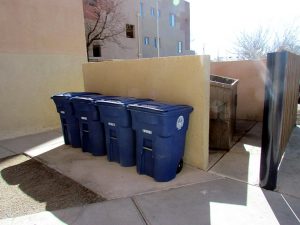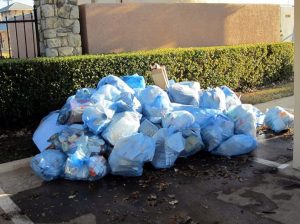 Certain tools such as pay-as-you-throw pricing and multi-family requirements have produced compelling diversion results in communities across the country. Leaders of several programs recently shared advice for colleagues who hope to achieve similar success.
Certain tools such as pay-as-you-throw pricing and multi-family requirements have produced compelling diversion results in communities across the country. Leaders of several programs recently shared advice for colleagues who hope to achieve similar success.
Recycling policies often come at the local level, as state legislation can be much more difficult to enact.
“Often local governments can actually get more traction by passing their own local ordinances,” said Susan Bush, senior consultant with RSE USA, on a recent webinar.
A wide variety of policies are available to choose from, and the webinar identified a few approaches that have more frequently yielded positive results. The webinar was presented by the State of Texas Alliance for Recycling in partnership with the Colorado Association for Recycling, New Mexico Recycling Coalition and Carton Council.
Incentivized diversion
“Pay-as-you-throw is probably the single most effective policy that we’ve seen impact recycling,” Bush said.
The approach acts to incentivize recycling by charging households more to dispose of more garbage. For example, customers can choose to pay less for a smaller garbage can or notably more for a larger one. That billing and service structure allows a household to decrease its garbage bill by increasing diversion. Loveland, Colo., a city of 75,000 that implemented the policy in 1993, is a prime example of the pay-as-you-throw (PAYT) impact.
“When this program went into place, it had effects right away,” said Tyler Bandemer, solid waste division superintendent for the city of Loveland.
Residential diversion rates have exceeded 50 percent each year since PAYT was implemented, Bandemer said. Since 2009, the city has reached at least 60 percent diversion. As a result, Loveland has the highest residential diversion rate of any community in Colorado, according to a recent study by the Colorado Public Interest Research Group and Eco-Cycle, a nonprofit MRF operator.
Mandatory multi-family
Sometimes the best way to drive up diversion is to expand access to recycling, and for many communities, that means opening it up beyond single-family residential access.
One way to expand recycling service is to require landlords to provide recycling access for multi-family properties. In Fort Worth, Texas, the city passed a multi-family recycling ordinance in 2011, mandating recycling access for all buildings with eight or more units.
The law requires landlords to have a recycling plan in place. The requirements for a plan were fairly broad, with most of the specifics and logistics worked out between the landlord and hauler, explained Debbie Branch, solid waste superintendent for the city of Fort Worth.
“Definitely the way that works best for apartment complexes – but is also the most expensive – is a program similar to a transparent blue bag program,” Branch explained.
The tenants put their recyclables in a blue bag, and on a designated day each week the hauler collects them. If one bag has contamination, it can be thrown out without ruining the whole load. This system, Branch said, works much better than an unattended dumpster for recyclables.

Under a system for multi-family recycling in Fort Worth, Texas, each tenant places recyclables in transparent bags, allowing the hauler to easily identify contamination.
“Gross contamination can easily occur when it’s the law of the commons,” she said, defining the expression to mean, “if it belongs to everybody then it belongs to nobody.”
When it passed in 2011, the law gave apartment managers roughly two years to come into compliance. That gave landlords time to come up with a plan, and also staved off claims that the city was unfairly rushing the ordinance into effect.
Collaboration for smooth implementation
Albuquerque, N.M. implemented a similar multi-family recycling program in 2007, requiring that complexes of 25 units or more provide service to their tenants. More than 400 complexes meet that criteria, and the program services more than 52,000 multi-family housing units.
The city considers “single family” to mean a property with up to eight units. That means any complex with nine to 24 units is not required to provide recycling service but can do so on a voluntary basis.
Under the program, the complex receives a number of weekly collected 96-gallon recycling carts, with the quantity dependent on the total number of units. The landlord’s can alternatively choose to receive a six-cubic-yard dumpster that’s collected multiple times a week.
The city has one set of accepted materials for single-family, multi-family and commercial clients.
Building support for the multi-family ordinance took a combination of strong leadership from the mayor and collaboration with many stakeholders, explained Jill Holbert, associate director of the city’s solid waste management department.
The city worked particularly with the local apartment property owners association, which was a “major stakeholder” in the process. The group was the most vocal opponent of the policy both before and after it was implemented, and was not completely satisfied with the end result, Holbert noted.
But the city and industry group still maintained lots of communication and continued to work together through implementation of the program.
“It was a relationship that was important to have, either way,” Holbert said.
One compromise that came out of that push-and-pull process was the 25-unit threshold for requiring service. The gap that leaves out buildings of between eight and 25 units came out of negotiations with the industry group.
Other impactful tools
Hauler licensing, registration or permitting is also very effective, Bush added. This means licensing beyond simply vehicle safety or insurance requirements. It can be used to require haulers to provide certain levels of service, she explained.
“It’s a very flexible type of policy, and it can be used to, over time, implement more advanced policies and programs,” Bush said.
Programs also need robust end markets and adequate funding. Goals and performance tracking can help ensure a program is succeeding and continues to progress, Bush said.
She added that policies must be complemented by other supporting efforts, as well.
“Policies themselves aren’t going to get this job done. There are other critical elements that need to be in place to make programs successful,” Bush said, noting that those include enforcement, communication and education.
For communities unsure how to move a policy forward, or those simply seeking more information on the policies that are out there, Bush pointed to a resource from the Carton Council that lays out sample ordinance language, case studies and more. Although the resource is carton-focused, Bush noted the tools that help one material are likely to benefit the wider stream.
“Most of them help all commodities,” she said. “Pretty much, the ‘rising tide floats all boats’ approach.”
More stories about local programs
- Study links tagging tactics to lower contamination rates
- Interstate Waste buys North Atlantic in Connecticut
- Iowa firm recycles wind turbine blades into concrete



